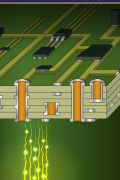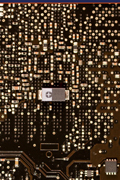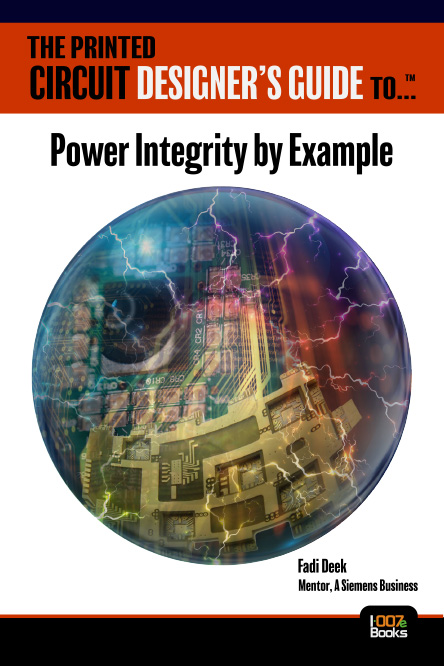There are many factors to consider when aiming to establish and maintain power integrity, from cavity thickness to the presence or absence of a voltage regulator.
Written by signal/power integrity specialist Fadi Deek of Mentor, A Siemens Business, this micro eBook provides a thorough investigation of power distribution network performance. Deek addresses problematic issues within electronic transmissions, and presents a variety of simulations and analyses in every chapter.
After you've read this eBook, you will better understand cause-effect relationships between varying factors and how to consider these when making design decisions.
ISBN: 978-0-9982885-7-4
 In 2005, Fadi received his B.S. degree in computer and communications from the American University of Science and Technology (AUST) in Beirut, Lebanon. That same year, he joined Fidus Systems as a design engineer. He designed circuit boards at Fidus for three years. In 2010, he received his M.S. in electrical engineering from the University of Arkansas in Fayetteville. He then joined Mentor, A Siemens Business, as a corporate marketing engineer. In 2013, Deek became a corporate application engineer supporting the HyperLynx tool suite. In parallel, he is also pursuing his Ph.D. at the University of Colorado in Boulder under the supervision of Dr. Eric Bogatin.
In 2005, Fadi received his B.S. degree in computer and communications from the American University of Science and Technology (AUST) in Beirut, Lebanon. That same year, he joined Fidus Systems as a design engineer. He designed circuit boards at Fidus for three years. In 2010, he received his M.S. in electrical engineering from the University of Arkansas in Fayetteville. He then joined Mentor, A Siemens Business, as a corporate marketing engineer. In 2013, Deek became a corporate application engineer supporting the HyperLynx tool suite. In parallel, he is also pursuing his Ph.D. at the University of Colorado in Boulder under the supervision of Dr. Eric Bogatin.
Mentor, A Siemens Business, is a world leader in electronic hardware and software design solutions providing products, consulting services, and award-winning support for the world’s most successful electronic, semiconductor, and systems companies. We enable companies to develop better electronic products faster and more cost-effectively. Our innovative products and solutions help engineers conquer design challenges in the increasingly complex worlds of board and chip design. Corporate headquarters are located at 8005 S.W. Boeckman Road, Wilsonville, Oregon 97070-7777. Website: www.mentor.com.
Related Video:
One of the most common outputs from a DC Drop simulation is a current density plot. But how much is too much current density? The answer depends on temperature rise, and requires a PI-Thermal co-simulation to properly characterize. With HyperLynx PI you can quickly pinpoint problems in your PCB's power distribution network.
 Eric Bogatin Dean, Signal Integrity Academy
Eric Bogatin Dean, Signal Integrity Academy
Professor Bogatin has a BS in physics from MIT and an MS and PhD in physics from the University of Arizona. He has worked in various industry roles, including senior engineering and management positions at Bell Labs, Raychem, Sun Microsystems, Ansoft, and Interconnect Devices.
Consulting Technical Editor,  Happy Holden
Happy Holden
I-Connect007
Happy Holden is the retired director of electronics and innovations for GENTEX Corporation. Formerly, he was the chief technical officer for the world’s largest PCB fabricator—Hon Hai Precision Industries (Foxconn). Prior to Foxconn, Holden was the senior PCB technologist for Mentor Graphics and [...]
Chapter Summaries
-
Chapter 1
Chapter 1: Bare Cavity
Chapter 1 discusses electrical properties and electronic components related to PCBs.
-
Chapter 2
Chapter 2: Decoupling Capacitor and VRM Effects
Chapter 2 presents two techniques to lower the impedance of a cavity.
-
Chapter 3
Chapter 3: Transparent Cavity
Chapter 3 explores different placements for decoupling capacitors and the impact of different locations on spreading inductance.
-
Chapter 4
Chapter 4: Cavity Noise and Via-to-Via Coupling
Chapter 4 addresses how to reduce crosstalk and noise between vias in the cavity.
-
Chapter 5
Chapter 5: Reducing Via-to-Via Coupling Using Capacitors
Chapter 5 details ways to reduce crosstalk from all vias at once and two methods to reduce cavity impedance.






